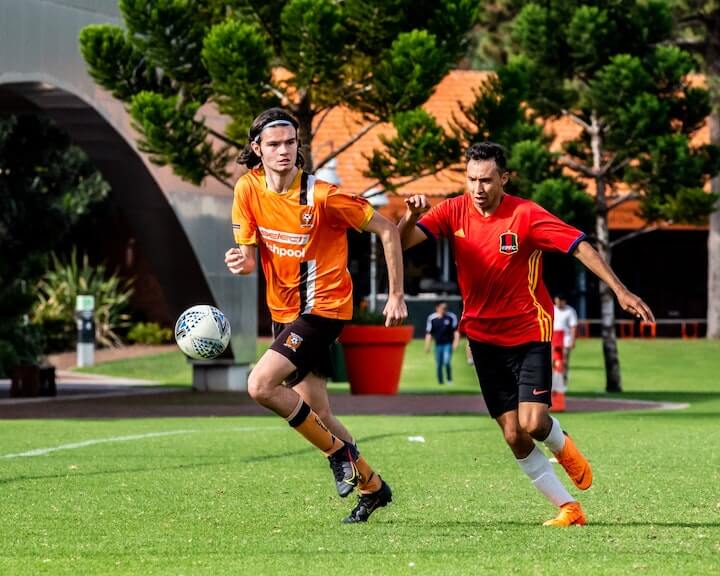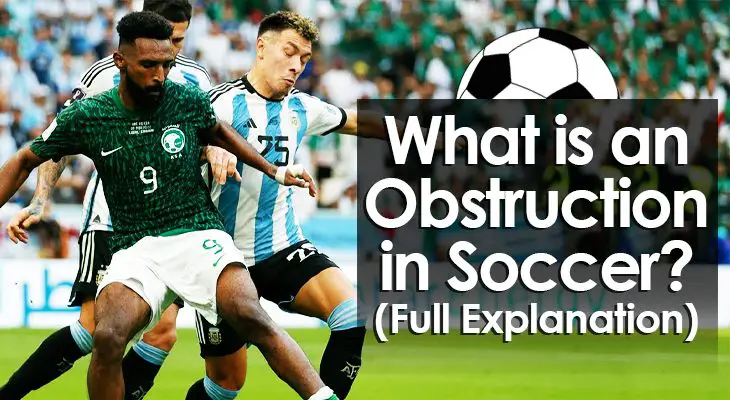What is an Obstruction in Soccer? (Full Explanation)
Obstruction in soccer refers to a type of foul where a player impedes the progress of an opponent when the ball is out of playing distance.
Even if the contact is minimal, the offender’s intent to stop the player rather than the ball makes it an unfair challenge.
You’re likely to witness multiple obstruction calls in any soccer game.
However, despite it being a popular term with players, coaches, and commentators, "obstruction" hasn't been featured in the official Laws of the Game since the late 90s.
As the game evolves, so do the rules.
Read on for a more up-to-date breakdown of the obstruction rule.
What is Obstruction in Soccer?
Obstruction in soccer refers to the act of “impeding the progress of an opponent”.
This is part of Law 12: Fouls and Misconduct, which you can see in our soccer rules post.
Impeding the progress of an opponent involves stepping into the path of a player to block them, slow them down, or force them to change direction.
However, it’s important to note that these factors come into effect when the ball is out of the playing distance of either player.
So, initiating physical contact with an opponent when the ball is there to be won is legal but, impeding their progress when chasing after a ball is not.

Obstruction Rule Breakdown
a. Players’ Rights to Their Position on the Field
As explained by IFAB, each player has the right to maintain their position on the field.
This means that stepping into the path of an opponent is different from simply being in their way.
When it comes to obstruction in soccer or impeding progress, the act of moving into an opponent’s path is the primary factor in causing an offense.
This is one of the most important distinctions of the rule and is often the source of debate.
Even if there is minimal contact with the opponent, moving into their path as they run means you’re likely to get called for a foul.
All players have the right to hold their position on the pitch, so make sure yours is an advantageous one!
If you happen to be in a player’s path when competing for a ball outside of playing distance, it’s their responsibility to get around you.
b. Within Playing Distance
Another significant feature of obstruction in soccer is playing distance.
Whether or not the ball is within playing distance is often the difference between a foul or a legal tackle.
"So what is legal playing distance?"
Playing distance is loosely defined as within range to get a touch on the ball.
The vagueness of the term is intentional to leave some interpretation to the referee. To encourage the free-flowing and creative soccer, many rules aren’t clearly defined.
So in terms of playing distance, there is no numerical definition.
Rather, the referee will consider both players’ positions as well as the location and trajectory of the ball to determine whether contact is obstruction or legal.
In most cases, playing distance falls within a radius of around three feet.
Therefore, if the ball is within playing distance, you may challenge, block, shield, or impede your opponent, as long as the level of contact isn’t excessive.
Legal Obstruction in Soccer
By now, you probably realize that there is a gray area when it comes to the obstruction rule.
So it’s important to know how to challenge for the ball and use physicality legally.
Here are some defending tips to help reduce the number of obstruction calls made against you.
Tip #1: Defensive Positioning
Being in the right position is a skill and ensures you have the best chance of dispossessing an opponent.
Pay attention to your opponent’s movement and tendencies, especially during transition.
Make sure you always have an angle to close them down or cut them off when competing for the ball.
Tip #2: Body Shape
One of the main reasons defenders get called for obstruction is for standing square against their opponent.
This makes it virtually impossible to avoid a foul if the ball is behind you.
Always adopt a side stance in 1v1 situations so you can engage the opponent while staying ready to turn and sprint for the ball.
Tip #3: Timing
When chasing a pass with an opponent, wait for the right time to make contact.
Doing so too early may lead to getting flagged for obstruction.
Wait until the ball is within playing distance then make a fair challenge.
Tip #4: Balance
When caught off balance, defenders tend to panic, leading to desperate lunges and illegal blocks.
Remain balanced and on your toes at all times so you’re ready to react to an over-the-top pass or a 50/50 challenge.

Penalty for an Obstruction in Soccer
The typical punishment for an obstruction in soccer is a direct free kick for the opposition.
If the foul occurs inside the offender’s penalty box, it results in a penalty for the opposition.
However, the referee may also give a yellow card to the offender in the following circumstances:
- The foul is deemed reckless
- The foul disrupts a meaningful attack (e.g. a counterattack)
- The offender has already committed a series of fouls.
The referee may send the offender off (red card) if the foul denies a clear goal-scoring opportunity or they award a second yellow card.
Conclusion
Obstruction in soccer is one of the most common fouls in the game at every level.
Since this type of challenge often verges on the line between a fair tackle and an illegal block, obstructions are hotly contested.
Understanding the rule fully is essential for developing a better defensive skillset, and will lead to fewer frustrating moments on the field.
Use this guide to gain a better understanding of soccer laws and leverage this knowledge to improve your game.

